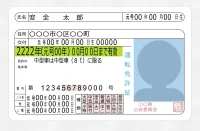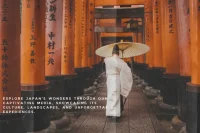What is the Japanese Doll Festival? Explore its charms from its origin and history!
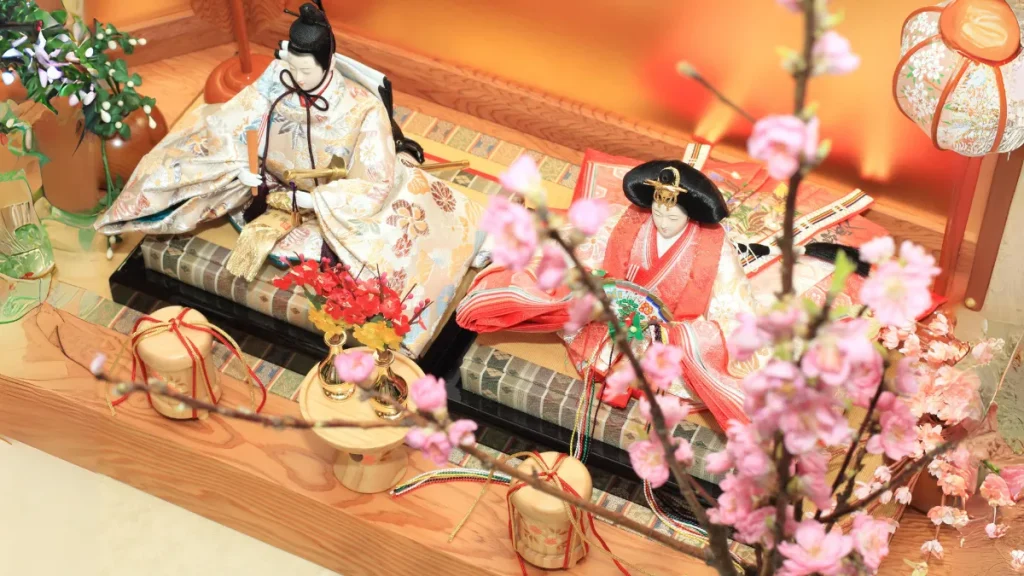
To all foreigners living in Japan, do you know about Hinamatsuri?
This article explores the deeper meaning behind the tradition, focusing on the following aspects of the Doll Festival, which is celebrated every spring.
- Explanation of the origins and history of Hinamatsuri
- Meaning of the Doll Festival and Hina Dolls
- Hinamatsuri customs by region
Through this article, you will be able to unravel the history of Hinamatsuri and understand its meaning and origin. Let's explore this beautiful Japanese festival together to enjoy the next Hinamatsuri more!
What is the Doll Festival?
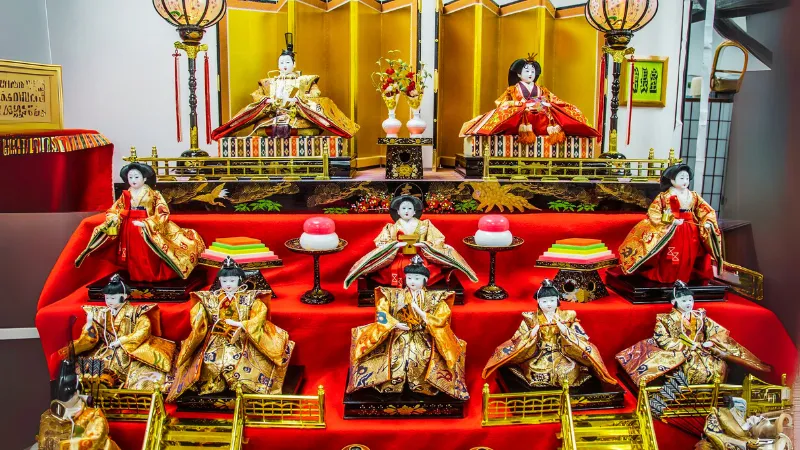
Hinamatsuri, also known as Peach Festival, is a traditional Japanese event held every year on March 3. It is a time to wish for the healthy growth and happiness of girls and to pray for good health and good fortune. It is a festival where family and friends gather to decorate dolls, share a festive meal, and celebrate the arrival of spring.
Here, we will look back at the origin and history of Hinamatsuri and explain the meaning of Hinamatsuri.
Origins and History of the Doll Festival
The origin of Hinamatsuri is said to be a combination of the ancient Chinese "Festival of the Snake" and the custom of "floating dolls" to drive away evil spirits.
In ancient China, there was a custom called "Kamisno-Sekku" to purify the body by the riverside on the first day of the snake in March to drive away evil spirits. On the other hand, in Japan, there is a custom called "Ningyo Nagashi," in which people use dolls made of paper or plants to prevent illness and misfortune by stroking their bodies and transferring evil spirits, and then float the dolls down a river.
The two customs gradually became linked with Hiina-asobi, a play with paper dolls popular among the children of aristocrats during the Heian period (794-1185), and transformed into an event to exorcise evil spirits using dolls. In the Edo period (1603-1867), Hinamatsuri spread to the general public and became an annual event to pray for the healthy growth of girls.
Thus, a brief summary of the history of Hinamatsuri shows that it is a fusion of ancient Chinese customs and Japanese traditions, changing its form throughout its long history to take its present form. Hinamatsuri began in the Heian period (794-1185) as a traditional Japanese event to celebrate the growth of girls and to pray for good health during the changing of seasons, and has taken root in people's lives for about 1,000 years.
Origin and Seasonal Meaning of March 3
There are many theories about the origin of Hinamatsuri, but a brief explanation is as follows. In ancient China, "Joushi-no-Sekku" means the day of the snake in early March, which was considered an unlucky day with an odd number of overlapping snakes and a turning point on which evil spirits were likely to be born. The "Joushi-no-Sekku" festival included a purification ceremony to purify oneself by the waterside, which was introduced to Japan and changed its form during the Edo period to become the current "Hinamatsuri" (Girls' Festival).
The time of Hinamatsuri is also an important time when the seasons change dramatically from winter to spring, a symbolic time when new life begins to sprout. For this reason, March 3 has had a special meaning since ancient times, and it is said that the origin of Hinamatsuri was the day to wish for health and happiness in the new year.
Symbol of the Doll Festival
The Hinamatsuri contains a variety of symbolic elements. Each has its own meaning and reflects Japanese culture and tradition. Let us introduce some of the typical elements below.
| doll | It is considered an important symbol of taking the place of a girl and facing bad luck. Dolls and utensils, each with its own meaning, are arranged to express the wish for a happy life for the girl. |
| peach blossom | Peach blossoms are an essential part of Hinamatsuri. Peach blossoms have long been a symbol of longevity, health, and protection against evil. Peach blossoms are also used to celebrate the coming of spring, and are displayed on the Girls' Day altar and inside the house to express the wish for the healthy growth of girls. |
| Special foods | Hishimochi, hina-arare, shirozake, chirashizushi, etc. are available. |
| color | The color scheme is characterized by peach and other colors that symbolize spring. Peach color expresses girlishness and also evokes the feeling of spring. |
Each element is more than a simple decoration or food; each has its own meaning of health, longevity, protection from evil, and other wishes for the Girls' Festival.
Role of Hina Dolls
The aforementioned hina dolls originally had a vicarious meaning and were beloved as a symbol to pray for children's good health. And each hina doll has its own role. The following is a brief explanation of the roles of hina dolls, an important element of the Hinamatsuri.
| UCHIRIRI-SHIRASAI and OHINASHI-SHIRAI (Odairisama, Ohina-sama) | Doll wedding ceremony with the main actors imitating the Emperor and Empress, symbolizing the girl's wish for a happy marriage. |
| any of a number of sets of three enlightened men, including (but not limited to): Buddha, Confucius and Christ (3) The three persons' alternatives. | The central courtesan, who serves the princess, is a married woman (only the central courtesan has black teeth and no eyebrows) and is responsible for pouring wine, reciting songs, and playing musical instruments. |
| five court-musician dolls at the Girl's Festival (in March) (Goninbayashi) | Musicians who enliven the banquet From left to right: "taiko", "otsuzumi", "kotuzumi", "fue", and "utai", each holding an instrument or a fan and able to play music. |
| Minister of the Left (official in Nara and Heian periods) (Sadahi, Udaijin) | The senior vassal to the lord, on his right is the left minister (senior) and on his left is the right minister. |
| three main items (e.g. tickets, pieces of cloth, etc.) (television or radio station) audience | Composed of three palace scullery maid's angry face, crying face, and laughing face. |
The way the dolls are lined up in a row, each in the shape of the emperor and empress and the people of the court, is meant to teach children etiquette and hierarchical relationships when they enter the world.
Hinamatsuri Decorations and Food

The Dolls' Festival features colorful decorations and special foods.
These mean more than beautiful decorations and delicious food; they are a part of the traditional culture and wishes for the Dolls' Festival. From here, let us introduce the meaning and cuisine of decorating peach blossoms.
Origin of the peach blossoms on Girls' Day
The custom of decorating peach blossoms for the Doll's Festival was once believed in China, where the peach tree was believed to have the power to ward off evil spirits. Peach blossoms also herald the arrival of spring and bring hope to people as they move into the new season. The pretty pink flowers are a symbol of healthy growth and beauty for women. By displaying peach blossoms, families also pray for the girl's health and happiness.
Peach blossoms have long been believed to have the power to ward off evil spirits, and decorating them in time for the Dolls' Festival is also meant to ward off evil spirits from the family for the year ahead and to wish for a clean and pure year. Against this background, peach blossoms probably play an important role in the Hinamatsuri.
Typical dishes and meanings of Girls' Day
Chirashi sushi, hishimochi (rice cakes), and amazake (sweet sake) are served on Hinamatsuri. These dishes are not only beautiful to look at, but also have meanings in their ingredients and shapes. Even today, the wishes and traditional culture contained in the decorations and dishes of Hinamatsuri will be passed on to the next generation.
rhombus-shaped mochi
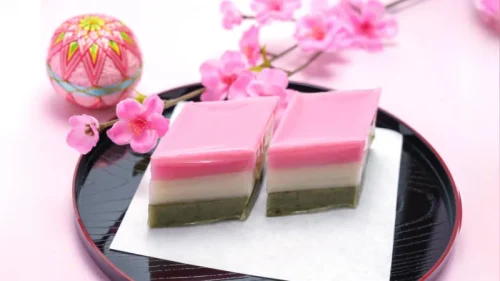
Hishimochi is a diamond-shaped rice cake consisting of three colored layers: green, white, and pink (rouge).
Green: health and longevity
White: cleanliness and purity
Pink: repellant of evil
The three colors are said to have the above meanings. These colors are also said to represent the coming of spring, when plants (green) sprout from under the snow (white) and peach blossoms (pink) bloom.
sweetened rice-flour cakes for offering at the Dolls' Festival
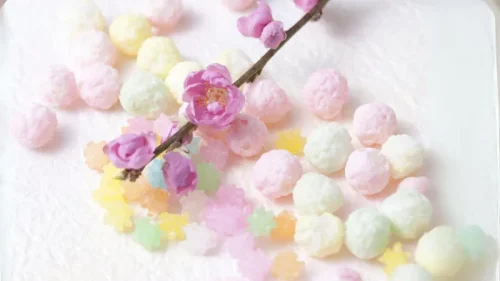
Hina-arare are colorful sweets made of rice and crushed water chestnuts. Originally, they were carried as portable food when going out with hina dolls. The colors have some of the same meanings as hishimochi, but in the case of the four colors, they represent the four seasons.
sushi rice in a box or bowl with a variety of ingredients sprinkled on top
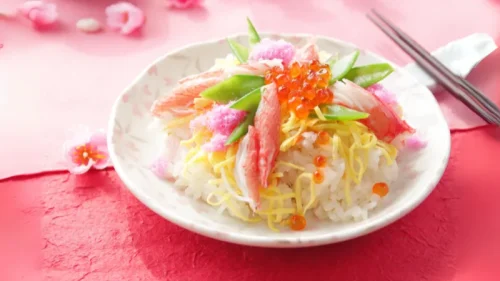
Chirashi-zushi is a celebratory sushi dish with colorful ingredients.
Shrimp: longevity
Renkon: the power to see ahead
Beans: Success at work, from the word "Mame (diligent) work".
Broiled Eggs: Gold and Silver Treasures Accumulated
Ikura: Expectations for offspring
clam's soup soup
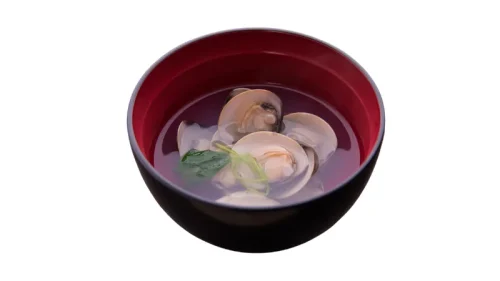
Hamaguri (clams) have long been considered a symbol of marital harmony because they do not fit together except as a pair of shells. It is a wish that a girl will meet a good marriage partner.
Hina Matsuri customs in various regions
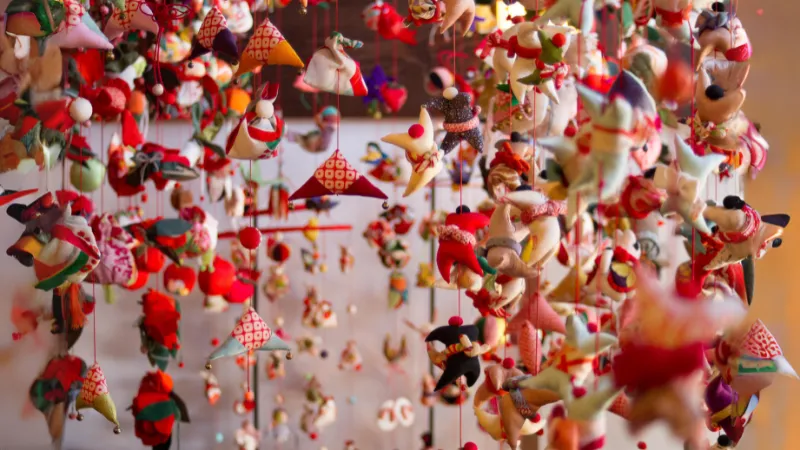
There are various forms of Hinamatsuri in different parts of Japan. Each region has different customs and characteristics, reflecting the culture and history of each area. Let's take a deeper look at the customs of Hinamatsuri throughout Japan and the unique characteristics of each region.
Differences between Kanto and Kansai
There are major differences between the Kanto and Kansai regions for the Hinamatsuri. The main points of interest are as follows
Position of female and male dolls
In the Kanto region, the male dolls (ODAIRI-SAMA) are displayed on the right (facing left). On the other hand, in Kansai, 逆に is displayed on the left (facing right).
In Japan, there has long been a belief that the left side of the body is higher in rank, because when one stands facing south, the east side is in the direction of the rising sun, and the person standing to the left is considered higher in rank. In the Meiji era (1868-1912), Western culture entered Japan, and the international manner in which the person standing on the left (facing right) was considered to be of higher rank took root. In accordance with international etiquette, the Emperor of Japan stood on the right side of the Empress, so the style was adopted and the male dolls were displayed on the right side.
In regions such as Kansai, where ancient customs are respected, the male dolls are still displayed on the left side (upper left style) in the old-fashioned way.
When to start decorating
In the Kanto region, decorations begin around February 4, the first day of spring, while in the Kansai region, decorations begin on March 3.
sweetened rice-flour cakes for offering at the Dolls' Festival
In the Kanto region, it is made of puffed up Uruchi rice and sprinkled with powdered sugar for a sweet flavor.
In Kansai, on the other hand, okaki is made from glutinous rice. They come in a variety of flavors, including soy sauce, salt, aonori (green laver) and mayonnaise.
Hinamatsuri customary events
The customary events of Hinamatsuri have various characteristics in different parts of Japan. Let us introduce some of the most famous Hinamatsuri customs.
NAGASHIBINA
This event is considered to be the prototype of Hinamatsuri, in which people pray for good health and safety by transferring evil spirits to dolls and floating them down rivers or into the sea. This event is held at Shimogamo Shrine in Kyoto, "Mochigase Nagashi-bina" in Tottori Prefecture, and "Edo Nagashi-bina" on the Sumida River in Tokyo, among others.
| Shimogamo Shrine, KyotoView Google Map Address: 59 Shimogamo-Izumigawa-cho, Sakyo-ku, Kyoto, 606-0807, Japan Access: 30 min. by city bus from JR Kyoto Stn. paper doll to which children pray for fine weather (usu. white, and shaped like a Buddhist priest)View Google Map Address: 32-1 Beppu, Yose-cho, Tottori City, Tottori Prefecture, 689-1211 Access: 7 min. walk from JR Yose Station Edo Nagashi Bina" at Sumida River, TokyoView GoogleMao Address: Near Azumabashi Water Terrace, Sumida Park, Taito-ku, Tokyo Access: 3 minutes walk from Asakusa Station on Tokyo Metro Ginza Line, 3 minutes walk from Asakusa Station on Tobu Skytree Line, 5 minutes walk from Asakusa Station on Toei Subway Asakusa Line |
Hina no Tsuridori
Hina no Tsurushi-dori, famous in Izu Inatori, Shizuoka Prefecture, are small doll decorations hung on both sides of the Hina-dan. This custom has continued since the Edo period and is known as one of the "three major hanging decorations in Japan" along with "Sagemon" in Yanagawa City, Fukuoka Prefecture and "Umbuku" in Sakata City, Yamagata Prefecture.
| Hina Doll Vine DecorationsView Google Map Address: 1521-3, Inatori, Higashi Izu-cho, Kamo-gun, Shizuoka Prefecture, 413-0411 Access: Inatori Onsen Station, JR Ito Line three main gateways (temple, shrine, and temple gate)View Google Map Tourist facilities, shopping streets, and stores in Yanagawa City, Fukuoka Prefecture paper umbrella makerView Google Map Address: 2-2-25, Hiyoshi-cho 2-chome, Sakata-shi, Yamagata 998-0037 |
There are many other events as well. In Kyoto, old machiya houses and temples and shrines display special hina dolls in the spring. These include old Hina dolls and Kyo Hina dolls of historical value, and visitors are treated to a taste of spring in the ancient capital.
The Katsuura Big Hinamatsuri (Katsuura City, Chiba Prefecture) is a large-scale event in which approximately 1,800 hina dolls are displayed on the stone steps of the Tomisaki Shrine, and many more will be displayed throughout the city.
| Big Doll FestivalView Google Map Address: 1, Hamakatsuura, Katsuura, Chiba 299-5233 Access: JR Katsuura Station→10 min. walk (Cape Tomisaki Shrine) |
These are events that attract not only locals but also many tourists from Japan and abroad, who can easily experience the charm of Hinamatsuri.
Many people continue to love the festival because it preserves local traditions and reacquaints them with new attractions. Hinamatsuri in various parts of Japan symbolize the richness of local culture and history, and each custom is carefully passed down to the next generation.
Reference:Shimogamo Shrine in Kyoto,Mochigase Nagashibina" in Tottori Prefecture,the three largest hanging ornaments in Japan,Katsuura Big Hinamatsuri (Katsuura City, Chiba Prefecture)
The Modern Meaning and Change of Hinamatsuri
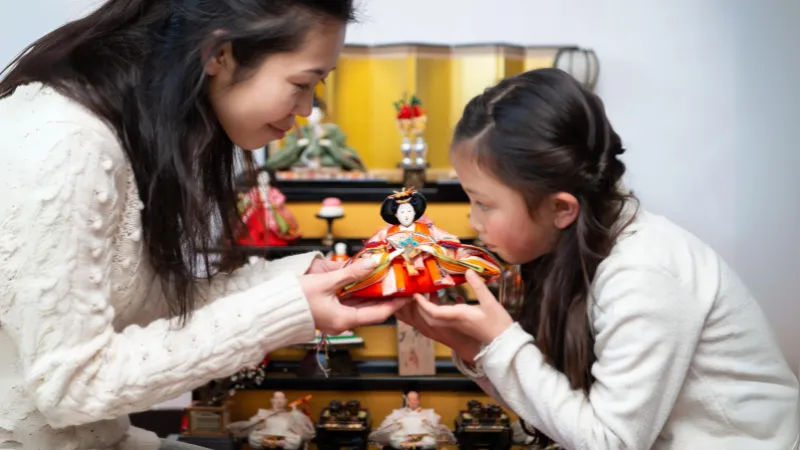
The meaning and role of Hinamatsuri has changed over time. Initially, it began as an event to ward off evil spirits and wish for the healthy growth of girls, but in modern times, it has taken on a new meaning as an important day to cherish family ties and to pass on culture.
Parents' Wishes for Girls' Day
Hinamatsuri has long been a time to wish for the happiness and health of girls. Parents wish for their children's good health and happiness, and the Hinamatsuri is filled with deep affection.
At home, parents and children enjoy decorating and cooking special dishes together. Local communities also engage in activities to pass on traditional culture to their children, and the meaning and wishes of Hinamatsuri have been handed down from parents to children.
Doll Festival in the Modern Home
Modern Hinamatsuri is celebrated in different ways by different families. Changes in society, such as the shift to nuclear families and women's advancement in society, have also affected the form of the festival. For example, more and more households display miniature doll sets that can be easily decorated for only one day and then put them away immediately.
In addition, local communities and municipalities hold Hinamatsuri-themed events, craft classes for parents and children, and exhibitions of hina dolls.
In this way, Hinamatsuri is not only an annual event, but has been passed down through the generations, adding new values as the times change. The spirit of wishing for the health and happiness of the family will continue to be cherished in the future.
Serious employment support to help you realize your dream of working in Japan!

Do you want to work in Japan?
Let us "Goandup" make that dream a reality!
【 Program Features 】
✅ JLPT N3 level Japanese language acquisition
✅ Thorough preparation for the specific skills test
✅ Full support for job hunting in Japan
Business-focused one-on-one lessons will help you find a job in Japan in the shortest possible time.
【 Program Menu 】
- Individual Japanese language lessons
- Intensive curriculum to obtain N3, especially specialized lessons for business Japanese that can be used at work.
- Intensive curriculum to obtain N3, especially specialized lessons for business Japanese that can be used at work.
- Preparation for the Specific Skills Test
- Customized materials for specific skill tests will be used to focus on frequently asked questions and learning to pass the test.
- Customized materials for specific skill tests will be used to focus on frequently asked questions and learning to pass the test.
- Resume and CV support
- To create resumes and CVs tailored to Japanese corporate culture, and to brush up on self-promotion and motivation for application.
- To create resumes and CVs tailored to Japanese corporate culture, and to brush up on self-promotion and motivation for application.
- Interview Preparation
- Guidance on areas for improvement through mock interviews and feedback based on corporate interview scenarios. Learn interview etiquette and behavior unique to Japan.
- Guidance on areas for improvement through mock interviews and feedback based on corporate interview scenarios. Learn interview etiquette and behavior unique to Japan.
- career consulting
- Provide introductions to companies that match the participant's career goals, select companies to apply to, and provide advice on the level of knowledge required by the companies to which the participant is applying.
- Provide introductions to companies that match the participant's career goals, select companies to apply to, and provide advice on the level of knowledge required by the companies to which the participant is applying.
- Chat Support
- In addition to one-on-one individual lessons, we also accept casual questions via DM (visa application, living support, assistance in finding a room, etc.).
If you are serious about your career in Japan, join us now!
▶︎ for more informationclick here.
We will do our best to support your success in Japan!
summary
We took an in-depth look at the historical background of Hinamatsuri and how it has evolved in modern times.
- Hinamatsuri is an event to wish for the health and happiness of girls
- Peach blossoms are meant to ward off evil spirits and hina dolls are meant to keep misfortune away.
- Customs and events for Girls' Day differ from region to region.
- Modernization has changed the way we celebrate.
By following these points, we hope you will gain a deeper understanding of the rich traditions and changes of Hinamatsuri. Hinamatsuri, which symbolizes the beautiful culture of Japan, will continue to be passed down with great care by many families in the future.
Your support will help us!
Thank you for visiting Goandup Picks. Our mission is to provide you with more useful information to show the world what Japan has to offer.
Your support will help us to further enhance our activities, so please support us!




